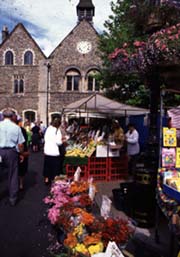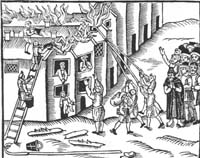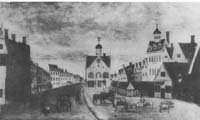| c.1900 | A photograph of a Market Day on the Buttermarket shows it busy but not over crowded and only a few stalls where today there are three full rows. |
| 1958 | The Cattle Market was moved westwards, away from the St Andrews Street frontage to provide car parking for the town centre. New covered pig pens were provided together with a new lorrywash. This was still the current site in 1998, and remained so until the eventual demise of the Cattle market in December of that year. |
| 1961 | Buses leaving the Bus Station were finally banned from driving through the Buttermarket on market days, to avoid further damage to the portico of the Suffolk Hotel. |
| 1968 | New market bye-laws introduced. |
| 1974 | St Edmundsbury Borough Council was formed from the old Bury St Edmunds Borough Council, Haverhill Urban District Council, Thingoe Rural District Council and Clare Rural District Council. The new Council took over responsibility for the Bury markets, and the provision market held in Haverhill on a Friday and Saturday. There was a market held in Clare, but this was run by the Parish Council, and continues to be under their control in 1997. |
| 1986 | The Borough Council first introduced market regulations. Modern conditions of open government and administrative justice meant that the Market Traders Committee were consulted on the proposals and the regulations adopted with their support. The regulations governed stall location and market discipline and very importantly by this time, controlled the sale of the goodwill of sites. Rules were adopted to control the future composition and locations of traders. |
| 1986 | The growth of rival markets, usually disguised as car boot sales, was met by adopting S.37 of the Local Government (Miscellaneous Provisions) Act 1982 requiring prior notice of such events. |
| 1987 | Sainsbury's supermarket moved from the Cornhill to Moreton Hall on the edge of town. The land had been acquired in 1984 causing the future of the town centre to come into question. |
| 1988 | There was a major review of market regulations in full consultation with the Traders Committee, resulting in 2 or 4 days suspensions being introduced for breaches of market regulations. Traders would pay for 48 weeks of the year, whether attending or not. The licence holder must attend personally for 1 week in 4, and no companies or partnerships could trade. |
| 1989 | Serious consideration was given to relocating the Livestock Market to allow for retail redevelopment, and a Cattle Market Redevelopment Working Party was set up. |
| 1990 | Consultant Chartered Surveyors, Drivers Jonas reported on the commercial future of the Provision Market. They concluded that the market could be more profitable to the Council if a management agreement was made with a commercial market operator (i.e., farmed out). The Council decided to retain its own control but adopted a business plan to improve its income and resolved to review its charging policy. |
| 1991 | A 3 zone charging policy was adopted, with a higher price per foot of frontage charged in the areas with the best flow of pedestrians. This was the final major change in the last half decade of market reforms which ensured a dynamic future for our street market when these are declining elsewhere in the country in the economic recession. |
| 1992 | By this date electric power supplies were made available to all stalls which needed it to comply with legislation. The market was extended into the Traverse under its Business Plan. |
| 1993 | Simpson's cattle market site was sold to the Council, who leased it to Lacy Scott, the last remaining livestock auctioneer in Bury. |
| 1994 | Supported by Market Traders, the Council lobbied Government not to take away their market rights as proposed in the Deregulation Bill. It also decided not to proceed with the redevelopment of the Cattle Market site. |
| 1996 | The markets joined in the Great British Market Week, a national promotion to boost the appeal of markets to shoppers. |
| 1997 |
During 1997 the Bury Corn Market, still held in the Corn Exchange every Wednesday, dwindled to the extent that no merchants bothered to turn up any more. It died out because most of such trades were now carried out under contract between buyers and sellers.
Meanwhile the beef trade had been hit by the disease BSE, followed by the subsequent ban on the sale of beef on the bone. The livestock market at Campsea Ashe, by Wickham Market, had also recently closed because of falling trade and tighter regulation of slurry disposal at markets.
|
| 1998 |
In January Lacy Scott started a Monday livestock market to replace the market they were forced to close at Wickham Market, in East Suffolk.
In June 1998, the Banbury Cattle Market closed after 800 years.
In August, following a drop in cattle sales caused by the BSE crisis, and a disastrous fall in pig prices, Lacy Scott gave up the lease on Simpson's market area in Bury and the Council demolished it to provide 80 car park spaces in time for Christmas.
A new Cattle Market Redevelopment Working Party was set up in April to discuss the whole future of this site again.
However, the decision was taken out of the Council's hands. In December, Lacy Scott and Knight announced the complete closure of the livestock market in Bury St Edmunds, and they gave up their lease of the Council's pig pens and lorry wash. Not only were economic factors in play, but throughout the year animal rights protestors had harried the operators and the council about the market. The so-called "Deadstock" market still remained open, but 370 car parking spaces now became available to the general public every Wednesday.
Thus, in the end, it was economic factors which finished off the Cattle market in Bury St Edmunds at the end of 1998.
The Provisions Market continued to flourish on the Cornhill and Buttermarket on Wednesdays and Saturdays.
|
| 1999 |
The year 1999 opened with some attempts to rescue the livestock market operations, but what trade remained was carried out on a local farm. In May, the Chelmsford Livestock Market ceased animal sales. The European Community beef ban was lifted in August, having been in force since March 1996. In its wake, only Colchester and Norwich were left with livestock markets operating to serve the whole of East Anglia.
|
| 2000 |
The old pig sheds on the ex-Livestock market site in Bury were demolished and replaced by 103 new car parking spaces. As if to seal the fate of the livestock market, the old Market Tavern, at the top of Risbygate Street, was turned into a wine bar called Number Three. The Market Tavern is traceable back to a document of 1674, and seems to have been called the Wagon until the 1920's.
|
| 2003 |
On 10th December, 2003, Fabian Eagle held his last poultry sale at Bury Market. It was known to the Council as the Deadstock Market, to distinguish it from the Livestock Market which had dealt with pigs, sheep, and cattle. The term "deadstock", included live poultry, ducks, rabbits and guinea pigs, as well as dead pheasants and other game. Wood was sold, and general bric a brac was up for auction. There was also an established vegetable stall, which sold flowers and plants in season as well. For many years this sale had traded as Vincents, even when owned by the one-time Mayor of Bury St Edmunds, Mr Ted Spooner.
The only remnant of the old market on the site to survive was Mrs Pettitt's Tea Hut, which would finally close in August 2006.
Photographs of the last day , taken by David Albon, a collector of fancy fowl, can be seen by clicking here:
"The Last Deadstock Market"
|
| 2004 |
In October, 2004, a revised design for the Cattle Market redevelopment was made public. New architecture and a wider link through to the Cornhill were its main features. This plan required the acquisition of Stead and Simpsons and Top Shop, to double the width of Market Thoroughfare. It was followed by a Parish poll of Bury Town council voters to gauge public opinion. This resulted in a majority of those voting being opposed to development. A poll published by the Borough Council showed a majority in favour of it.
|
| 2006 |
On 2nd August, 2006, the final chapter of Bury's Livestock market was written when the long established Tea Hut was closed down. The lease was up and the council had given notice of closure in order that the site could be finally cleared prior to redevelopment as a shopping centre. Before its life as a Refreshment Hut, this bulding was reputedly the Barber's Shop at Blenheim Camp, having been sold off when the camp was downsized.
|
| 2007 |
Demolition work began on the Cattle Market redevelopment site in January, 2007. Building work carried on throughout the year, but even the name chosen for the new development, "The Arc", proved controversial.
|
| 2009 |
Bury St Edmunds received a boost on 5th March, 2009, when the new Cattle Market shopping centre opened. It was named the Arc, and had cost £100 million to build by Taylor Woodrow, on behalf of the developers, Centros Miller. It had taken two-and-a half years to build and included underground car park spaces. The major anchor store was Debenhams, housed in a futuristic domed building on two levels.
Debenhams was located on a new central area, called Charter Square. Two new streets led into Charter Square, called Auction Street and Gosnold Street. The Arc could be entered from all directions, including from Kings Road, where a new entrance, called Hanchet Square, had been constructed.
Economic conditions had led to the closure of even well known shops like Woolworths, and even the stallholders on the Provisions Market were finding it hard to make a living.
|
| 2012 |
The old toll booth or round house that stood on the cattle market in Bury St Edmunds was restored and re-erected at the Museum of East Anglian Life, Stowmarket and was launched at a special event on 18th June 2012 at MEAL's Stowmarket site. This had been a promise made when the Arc shopping development required its removal in 2006.
|






